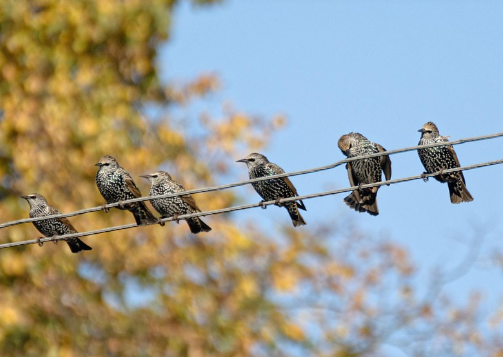
In 1890, 60 starlings were introduced to England. Over the decades, their population has grown to between 500 million and 1 billion. They are a nuisance, causing damage wherever they fly. Read on to learn more about the dangers starlings pose and what you can do if you encounter one.
Identifying Starlings And Their Dangers
While there are many species of starlings, the European starling is the most common in the U.S. These birds are about 20 cm in size and have black feathers with a metallic sheen, but they differ from other subspecies of starlings.
Starlings like to settle in cities or rural areas. They like to live near food sources, such as nesting in trees or on the eaves of buildings. Starlings are omnivorous animals and can quickly adapt to various environments.
Although starlings eat a lot of pests, the benefits they bring far outweigh the damage they cause. Large flocks of starlings can damage your buildings, plants, and crops. Every year, starlings cause millions of dollars in damage.
Why Are Starlings Such a Big Problem?
In England, starlings have no natural predators, and their rapid reproduction has led to a surge in their numbers. Thousands of them can gather and destroy your orchard in a matter of days. While fake scarecrows can scare off a few starlings, the sheer size of the flock makes them fearless and difficult to combat.
According to statistics, there were 953 dangerous incidents involving starlings on aircraft between 2001 and 2025. They can be sucked into engines, aircraft side exhaust fans, or even crash into aircraft. Although birds fly at low altitudes, they can still cause harm during takeoff or landing.
Furthermore, starlings are highly territorial, competing with other birds for prime nesting sites and attacking and driving away other species to protect their territory. This phenomenon creates a highly desirable breeding environment for starlings, contributing to their large populations.
These are just the tip of the iceberg of problems starlings cause; they are also a nuisance to business owners.
What Harm Can Starlings Do to You?
If starlings decide to use your buildings, equipment, or homes to build their nests, you could be in big trouble.
Garden, Farm Destruction:
If you grow fruits, vegetables, or other crops on your property, a flock of starlings can devour all your hard work in a matter of hours. If you enjoy feeding native birds, these rude starlings might actively visit your feeders and quickly devour everything.
Nest:
Starlings nest in corners or inside walls to ensure their nests are safe, and their nests can clog gutters and sewer pipes. They may also nest in your chimney, which can be a fire hazard.
Noise Problem:
A flock of starlings can wake you up in the morning. They are known for being noisy and can imitate the sounds of other birds, car alarms, mobile phone ringtones, and even human speech.
Damage From Bird Droppings:
Starling droppings are acidic. Large amounts can corrode your buildings and furniture, damaging paintwork and eaves, and may even require professional cleanup.
Like many pest birds, starlings can carry disease. Their droppings carry bacteria, fungi, and parasites that pose a serious threat to your family and pets.
If you notice starlings near your home, first remove their food sources and ice over their possible nesting sites. This will encourage them to choose other places to nest.
What is The Best Solution For Preventing Starling Damage?

What measures can you take to control starling populations during your starling control efforts? Physical deterrents, optical deterrents, and auditory deterrents are some of the most effective solutions for completely solving your starling problem.
You can use stainless steel or plastic bird netting to keep starlings out of your garden or farm. Use brackets to set up the netting to create a barrier that prevents them from getting through.
Use stainless steel or plastic bird spikes and install them on drains, buildings, and other structures to physically repel them. The blunt-angled spikes will irritate their claws without harming them.
Optical and Visual Deterrents:
Use shiny visual deterrents or bird-scare objects to intimidate birds. Use reflective tape, bird repellers, bird scare balloons, and owl decoys to intimidate birds and scare away starlings.
Auditory Deterrence:
Mimicking predator sounds or ultrasonic waves, or otherwise disturbing starlings.
If starlings are causing damage to your property, project, or business, use anti-bird spikes to prevent their infestation. We offer a variety of bird nets, bird spikes, and bird deterrents to help you completely eliminate starlings. Contact us for more information.
About Antibirdspikes:
Antibirdspikes is a leading bird control company in China, specializing in repelling birds from roosting and nesting areas. We specialize in urban bird control, providing humane and efficient bird repellent solutions. Our website offers a wealth of content and products to help people understand and find repellent solutions for a variety of bird and rodent pests. We also offer OEM/ODM services and wholesale. If you have any bird related concerns, please contact us.You can also read our free brochure to learn more about our products.



